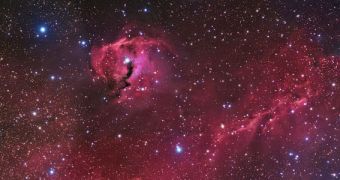In this new image captured by astronomer Michael Miller, the Seagull Nebula, known as IC 2177 among experts, can be seen flying high in the night sky, inside its home, the constellation Monoceros (the Unicorn). The object is located an estimated 3,650 light-years away from Earth.
Parts of the nebula also spread into the neighboring constellation Canis Major. In itself, this object is a HII region, which means that it is made up of a large, low-density cloud of partially ionized gas, which forms new stars at a frantic pace. The first HII region ever to be discovered was the Orion Nebula.
Vast amounts of glowing gas and dust can be seen in the image above. The glow is produced by massive amounts of ultraviolet radiations, which are emitted by young, blue stars within the nebula. Many of the stars themselves are not visible, since they are still cradled in their dusty cocoons.
Astronomers estimate that the Seagull Nebula is around 100 light-years in diameter. For comparison, our galaxy is around 100,000 light-years across. The most important star in this HII region is a massive, diffuse and irregular object called HD 53367.

 14 DAY TRIAL //
14 DAY TRIAL //